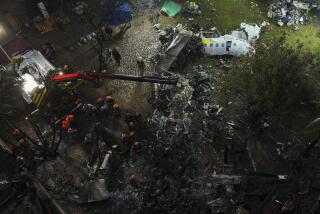Norwegians Brave Arctic to Investigate Russian Jet Crash
- Share via
LONGYEARBYEN, Norway — Braving the threat of rockslides and polar bears, investigators searched for bodies Friday on the icy, treacherous face of the Arctic mountain where a Russian jet crashed a day earlier.
The crash, Norway’s worst air disaster, killed all of the 141 people aboard the Tupolev Tu-154, most of them Ukrainian and Russian coal miners and their families returning to jobs after vacations at home.
En route from Moscow, the plane crashed Thursday morning just six miles from its destination--the airport on Spitsbergen, the main island in the Svalbard archipelago about 400 miles north of the Norwegian mainland.
The victims, employed by the Russian company Arktikugol, had worked in the archipelago in a Russian-operated mine. Although Svalbard is Norwegian, a 1920 treaty allows other countries to use the islands for nonmilitary purposes.
In addition to searching for bodies, investigators who flew to the crash site by helicopter Friday hoped to discover why the plane smashed into the 3,000-foot-high peak of Opera Mountain as it approached the airport.
Tor Oydvin, of the Svalbard governor’s office, said searchers discovered a key clue late Friday--the plane’s so-called black box, which records flight information.
Russia’s Itar-Tass news agency, quoting unidentified experts, said a sudden squall could have disrupted the flight. But Russian meteorologists said weather was probably not a factor.
Experts in Norway debated whether the lack of radar at the airport was a factor. Some said radar might have revealed that the plane was too low; others said its absence probably made no difference.
More to Read
Sign up for Essential California
The most important California stories and recommendations in your inbox every morning.
You may occasionally receive promotional content from the Los Angeles Times.













